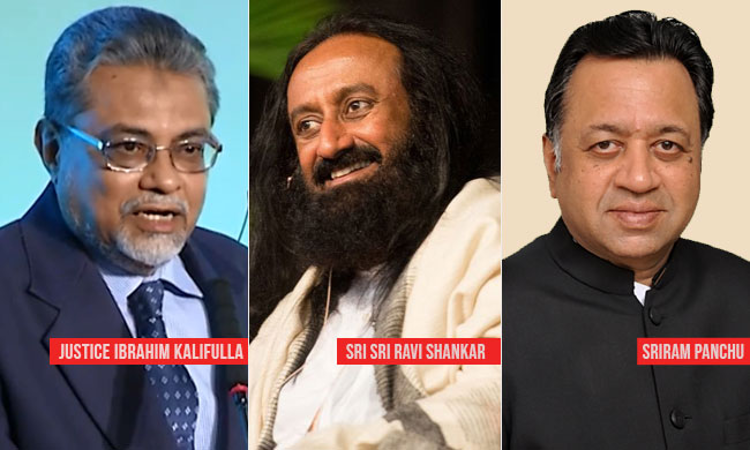The Ayodhya Mediation – An Optimist's View
A.J. JAWAD
19 March 2019 5:28 PM IST

Public opinion is divided on the decision of the Supreme Court of India to refer the Ayodhya dispute to mediation. There are some who welcome the decision in the hope that there will be a peaceful resolution of the long-pending, and at times bloody, dispute. However, others feel that this is not a fit case for mediation and that the Supreme Court is using mediation as a ruse to avoid the onerous task of deciding the vexatious issue.
Is the referral to mediation an abdication of responsibility by the Supreme Court?
In his book "The Idea of Justice", Amartya Sen discusses Arjuna's predicament before the Mahabharata war and calls it the consequentialist's dilemma. Lord Krishna, as the deontologist, advocates that it is Arjuna's duty to fight against adharma. But, when the war ends, with funeral pyres burning everywhere, women wailing and dead bodies lying scattered around, one wonders whether Arjuna, the consequentialist, was right. To understand the distinction between a consequentialist approach and a deontological approach, we need to understand the distinction between Niti and Nyaya, two very beautiful Sanskrit terms, equivalent of which is difficult to find in any other language. Sen explains that "Among the principal uses of the term niti are organizational propriety and behavioral correctness. In contrast with niti, the term nyaya stands for a comprehensive concept of realized justice".
The Supreme Court, in its institutional role as dispenser of justice, represents niti. But does institutional propriety work in the context of faith and belief? We have seen what happened post the Sabarimala judgment. The Supreme Court realised that its deontological approach can lead to disastrous consequences. Ayodhya imbroglio also involves faith and belief. There is also the fear of matsyanyaya (justice of the fish world - where the big fish devours the small fish) prevailing. The exercise of niti may not lead to nyaya. In order to ensure that real justice prevails (in contrast to a "just" judgment), it is imperative to get the big fish to agree with the small fish upon a solution mutually acceptable to both. It may not be totally according to law. But it will be nyaya, and will avoid the apocalyptic consequences of a judgment based on niti. Can we then fault the Supreme Court for choosing the better option?
Feasibility of mediation:
Mediation is a very scientific and structured process of conflict resolution. A trained mediator works by building up consensus between the parties in conflict by addressing their underlying interests and needs as opposed to their stated positions. It is a process that requires a number of skills – to listen to the parties; to handle emotions; to facilitate the negotiation process; to generate options; to break impasse that may frequently arise; to evaluate the options and arrive at consensus. The mediator assimilates all the information, deconstructs it, challenges the perceptions of the parties, helps them to see each other's perspective and thus carries them from an adversarial to a collaborative mode to develop consensus. Parties entering into direct negotiation may not have the benefit of such neutral intervention.
At first blush, the Ayodhya dispute seems to be an intractable one which simply cannot be resolved through a good-faith process like mediation. First and foremost is the highly emotive nature of the dispute with millions of people being passionately moved to taking conflicting stands based on faith, religious belief on the one hand and legal rights on the other. Secondly, it has huge political ramifications as political fortunes have been made or unmade on this issue. Is it possible at all to work through these seemingly impregnable layers to find common ground and build consensus?
In a TED talk, William Ury, expert negotiator and co-author of "Getting to Yes", points out that there is always a "third side" in any conflict. In the context of the Middle East conflict, William Ury talks about the history of the Middle East tracing it to the journey that the Prophet Abraham undertook across the Middle East. He calls it the "origin story" of the Middle East, the overarching message of the story being unity and hospitality. Ury calls Abraham the symbolic "third side" of the Middle East conflict.
If we look at the Ayodhya conflict from this perspective, it is seen that the people of Ayodhya have been living in peace and harmony even during the worst stages of the conflict. They simply wish to get on with their lives and livelihood in a conflict-free environment. Desperate efforts by vested interests to polarize the communities in this small town seem to have yielded little or no result. So what motivates them to live in harmony? Is it the struggle for existence or is it the message of justice and fairness of the central figure of this whole controversy - Lord Ram? Or is it both? Can the people of Ayodhya, along with Lord Ram, be the "third side" holding the key to a resolution? Well, it is for the mediators to explore this angle and see how they can work towards a resolution using the "third side".
To sum up:
Considering that mediation seems to be a better and more appropriate method to resolve this protracted conflict, it now depends on the good faith participation of the interested parties. Nothing can move forward without this good faith and a commitment to find resolution. Would it be a miracle if it happens? As an optimist, I love miracles.
A.J. Jawad is a mediator and trainer accredited with the Mediation and Conciliation Project Committee of the Supreme Court of India and ADR ODR International, UK and is the co-Founder and trustee of Foundation for Comprehensive Dispute Resolution, Chennai.
Views are personal only.


